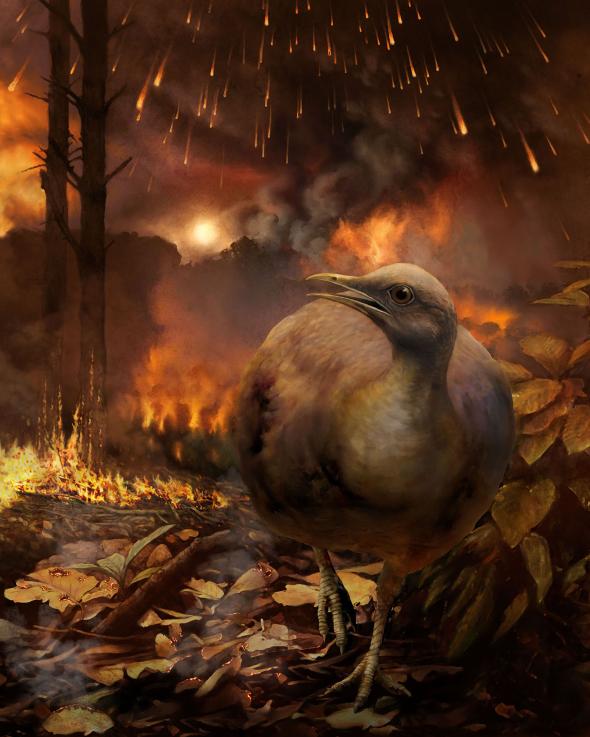
How Did Dino-Era Birds Survive the Asteroid ‘Apocalypse’?

Fossil spores and bird family trees suggest that deforestation was a key factor in determining who survived 66 million years ago.
When a nine-mile-wide asteroid struck Earth 66 million years ago, it exploded with a force greater than a million atomic bombs and wiped out three quarters of life on Earth, including the nonavian dinosaurs. But we know that some members of the dinosaur family tree survived, eking out a living in the post-impact world and eventually proliferating to become today’s birds.
The long-standing question, then, is why certain birds lived while others died in the mass extinction event at the end of the Cretaceous period?
Perhaps it’s because the impact and its aftermath obliterated forests worldwide, leading to the mass extinction of prehistoric tree-dwelling birds, researchers argue today in the journal Current Biology.
The only birds that survived were ground-dwellers, including ancient relatives of ducks, chickens, and ostriches. Following the cataclysm, these survivors rapidly evolved into most of the lineages of modern birds we are familiar with today, according to paleontologists led by Daniel Field at the University of Bath in the U.K.
“It’s an intriguing new hypothesis to explain both extinction and survival,” says Julia Clarke, an expert on bird evolution at the University of Texas at Austin.
“The extent to which the evolutionary histories of major modern groups, like birds, mammals, and flowering plants, were influenced by the end-Cretaceous mass extinction is only now coming into focus,” Field says.
“This global catastrophe left such an indelible signature on the evolutionary trajectories of these groups that we can still discern it 66 million years later.”
FERN SPIKE
Field and his coauthors compiled a mass of evidence from disparate sources to help support their argument. This includes data from massive new family trees for living birds, clues from newly discovered fossil birds, and an analysis of spores and pollen from the rock layer laid down immediately following the impact.
“The study came together bit by bit,” says Field. (See a rare dino-era bird wing found trapped in amber.)
It began with analysis of how bird ecology had changed over evolutionary history. After looking at the evolutionary relationships between the more than 10,000 bird species living today, the team realized it suggested the initial survivors had been ground dwelling, hinting that there had been global deforestation in their shared past.
“These analyses showed that the most recent common ancestor of all living birds, and all bird lineages that crossed the end-Cretaceous boundary, were likely ground-dwelling,” Field says.
Researchers had already long inferred the asteroid impact caused global wildfires, but the team has now bolstered the argument for total forest obliteration. Study coauthor Antoine Bercovici, a paleobotanist at the Smithsonian National Museum of Natural History in Washington, D.C., amassed data on fossil spore and pollen counts in rocks from many regions of the world, including New Zealand and the U.S.
In a thin rock layer formed during the first thousand or so years after the impact, 70 to 90 percent of the spores found come from just two species of fern.
“This fern spike represents evidence of ‘disaster flora,’ where pioneer species are rapidly recolonizing open ground, such as seen today when ferns recolonize lava flows in Hawaii or landslides after volcanic eruptions,” Bercovici says. (Did volcanoes also help kill the dinosaurs?)
It may have taken thousands of years for mature forests to return, the researchers say, and their composition was forever changed.
Furthermore, an analysis of the most common fossil birds of the late Cretaceous—a primitive group known as the enantiornithes—suggests most were tree dwelling. None of these birds survived, which the authors surmise was because their habitat had entirely vanished.
In addition, newly discovered fossil representatives of living groups of birds from the period shortly after the impact appear to have been ground dwellers, based on the proportions of their legs.
Source : https://news.nationalgeographic.com/2018/05/dinosaurs-asteroid-birds-forests-fires-paleontology-science/











